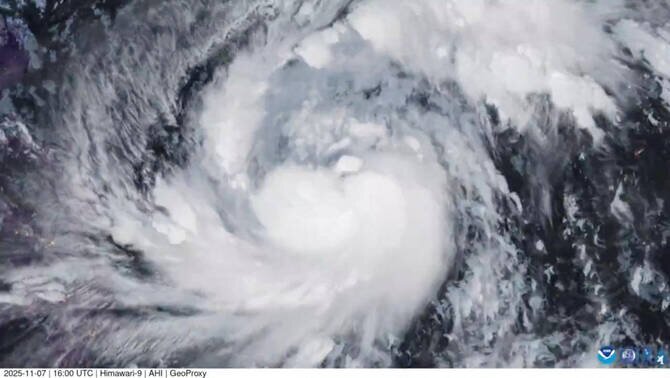
Philippines Braces for Deadly Storm Surges as Typhoon Fung-wong Nears Super Typhoon Strength
Typhoon Fung-wong, locally named Uwan, is forecasted to intensify into a super typhoon before making landfall on Sunday night.
MANILA: The Philippines' weather bureau has issued warnings of life-threatening storm surges and destructive winds as Typhoon Fung-wong approaches the country's eastern coast.
Forecasters predict that the typhoon will strengthen into a super typhoon before landing on Sunday night.
The typhoon's expansive circulation, spanning approximately 1,500 kilometers (932 miles), has already begun to affect parts of the eastern Philippines with heavy rains and strong winds.
According to PAGASA weather forecaster Benison Estareja, Fung-wong, which is currently producing maximum sustained winds of 140 kph and gusts reaching up to 170 kph, could intensify further, potentially reaching speeds of up to 185 kph before making landfall.
Residents in low-lying areas and coastal communities are at risk due to the possibility of storm surges reaching heights of five meters.
The PAGASA weather agency has advised individuals in these regions to evacuate to higher ground and suspend all marine activities.
Additionally, violent winds pose a significant threat, with the potential to destroy homes and topple trees and structures.
The typhoon is expected to bring heavy rainfall, with up to 200 mm forecasted for eastern provinces such as those in the Bicol region and parts of Samar.
Northern and central Luzon can anticipate rainfall ranging from 100-200 mm during its passage.
These conditions increase the likelihood of widespread flooding and landslides.
In preparation for Fung-wong's anticipated landfall, several local governments have canceled classes for Monday, and Philippine Airlines has canceled some flights.
The Philippines experiences a high frequency of typhoons due to its location along the Pacific typhoon belt, resulting in regular damage and casualties during peak storm seasons.
Just recently, Typhoon Kalmaegi caused significant destruction across the region, claiming 204 lives in the Philippines and five in Vietnam.
It also displaced hundreds of thousands and left many without electricity.
The lingering impact of Kalmaegi was felt in Thailand as well, where heavy rain and localized flooding occurred in parts of the northeast and central regions.
Scientists have pointed out that storms like Kalmaegi are becoming more powerful due to rising global temperatures, highlighting the increasing severity of weather events globally.
Forecasters predict that the typhoon will strengthen into a super typhoon before landing on Sunday night.
The typhoon's expansive circulation, spanning approximately 1,500 kilometers (932 miles), has already begun to affect parts of the eastern Philippines with heavy rains and strong winds.
According to PAGASA weather forecaster Benison Estareja, Fung-wong, which is currently producing maximum sustained winds of 140 kph and gusts reaching up to 170 kph, could intensify further, potentially reaching speeds of up to 185 kph before making landfall.
Residents in low-lying areas and coastal communities are at risk due to the possibility of storm surges reaching heights of five meters.
The PAGASA weather agency has advised individuals in these regions to evacuate to higher ground and suspend all marine activities.
Additionally, violent winds pose a significant threat, with the potential to destroy homes and topple trees and structures.
The typhoon is expected to bring heavy rainfall, with up to 200 mm forecasted for eastern provinces such as those in the Bicol region and parts of Samar.
Northern and central Luzon can anticipate rainfall ranging from 100-200 mm during its passage.
These conditions increase the likelihood of widespread flooding and landslides.
In preparation for Fung-wong's anticipated landfall, several local governments have canceled classes for Monday, and Philippine Airlines has canceled some flights.
The Philippines experiences a high frequency of typhoons due to its location along the Pacific typhoon belt, resulting in regular damage and casualties during peak storm seasons.
Just recently, Typhoon Kalmaegi caused significant destruction across the region, claiming 204 lives in the Philippines and five in Vietnam.
It also displaced hundreds of thousands and left many without electricity.
The lingering impact of Kalmaegi was felt in Thailand as well, where heavy rain and localized flooding occurred in parts of the northeast and central regions.
Scientists have pointed out that storms like Kalmaegi are becoming more powerful due to rising global temperatures, highlighting the increasing severity of weather events globally.










